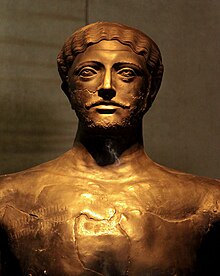Dhamar Ali Yahbur II: Difference between revisions
FuzzyMagma (talk | contribs) mNo edit summary |
FuzzyMagma (talk | contribs) m image Tags: Reverted Visual edit |
||
| Line 4: | Line 4: | ||
| titletext = |
| titletext = |
||
| more = |
| more = |
||
| image = |
| image = Dhamar Ali Yahbur II.jpg |
||
| image_size = |
| image_size = |
||
| alt = |
| alt = |
||
| Line 39: | Line 39: | ||
| religion = *[[South Arabian polytheism]] |
| religion = *[[South Arabian polytheism]] |
||
| type = King |
| type = King |
||
}} |
|||
{{About|3=Dhamar Ali Yahbur}} |
|||
'''Dhamar ʿAlī Yuhabirr''' (or '''Dhamarʿalī Yuhabirr''') (c. 321–324?) was a king of the [[Himyarite Kingdom]] (in modern-day [[Yemen]]). The definitive event during his reign was the submission of the [[Kingdom of Hadhramaut]]. Though he had a short reign, he was the founder of a new and remarkably stable dynasty of the Himyarite kingdom. By 500, only his and one other dynasty would rule. Significantly, with his reign, the hereditary transmission of successors became systematic and the king began to surround himself with a growing number of co-regents in order to facilitate the transmission of power. At first Dhamar'ali reigned alone, but he later would reign alongside his son [[Tharan Yuhanim]], who would succeed him. His name does not survive in the later Islamic tradition.{{Sfn|Robin|2012|p=263–264}} |
'''Dhamar ʿAlī Yuhabirr''' (or '''Dhamarʿalī Yuhabirr''') (c. 321–324?) was a king of the [[Himyarite Kingdom]] (in modern-day [[Yemen]]). The definitive event during his reign was the submission of the [[Kingdom of Hadhramaut]]. Though he had a short reign, he was the founder of a new and remarkably stable dynasty of the Himyarite kingdom. By 500, only his and one other dynasty would rule. Significantly, with his reign, the hereditary transmission of successors became systematic and the king began to surround himself with a growing number of co-regents in order to facilitate the transmission of power. At first Dhamar'ali reigned alone, but he later would reign alongside his son [[Tharan Yuhanim]], who would succeed him. His name does not survive in the later Islamic tradition.{{Sfn|Robin|2012|p=263–264}} |
||
== Inscriptions == |
== Inscriptions == |
||
Revision as of 15:51, 28 April 2024
| Dhamarʿalī Yuhabirr | |
|---|---|
| King of the Himyarite Kingdom | |
 | |
| Reign | 321–324 CE |
| Successor | Tharan Yuhanim |
| Died | c. 324 Yemen |
| Religion | |
Dhamar ʿAlī Yuhabirr (or Dhamarʿalī Yuhabirr) (c. 321–324?) was a king of the Himyarite Kingdom (in modern-day Yemen). The definitive event during his reign was the submission of the Kingdom of Hadhramaut. Though he had a short reign, he was the founder of a new and remarkably stable dynasty of the Himyarite kingdom. By 500, only his and one other dynasty would rule. Significantly, with his reign, the hereditary transmission of successors became systematic and the king began to surround himself with a growing number of co-regents in order to facilitate the transmission of power. At first Dhamar'ali reigned alone, but he later would reign alongside his son Tharan Yuhanim, who would succeed him. His name does not survive in the later Islamic tradition.[1]
Inscriptions
Dhamarali Yuhabirr is known from the following inscriptions:[1]
- Ir 31
- Ir 32
- Schmidt-Maʾrib 28 + Ja 668
- Garb Sab. Fragm. 5
- Graf 5
See also
References
Citations
- ^ a b Robin 2012, p. 263–264.
Sources
- McLaughlin, Daniel (2007). Yemen. Bradt Travel Guides.
- Robin, Christian Julien (2012). "Arabia and Ethiopia". In Johnson, Scott Fitzgerald (ed.). The Oxford Handbook of Late Antiquity. Oxford University Press. pp. 247–332.
